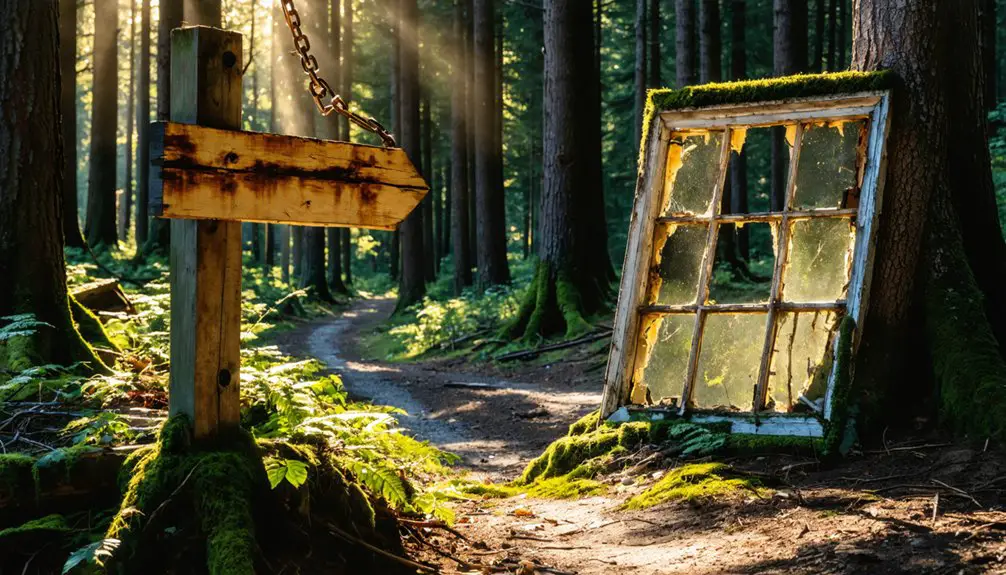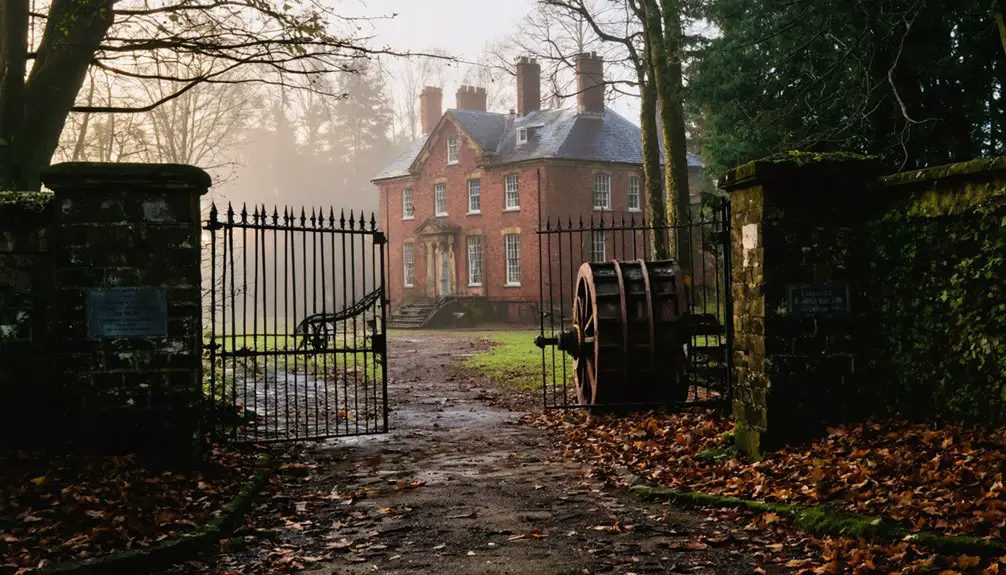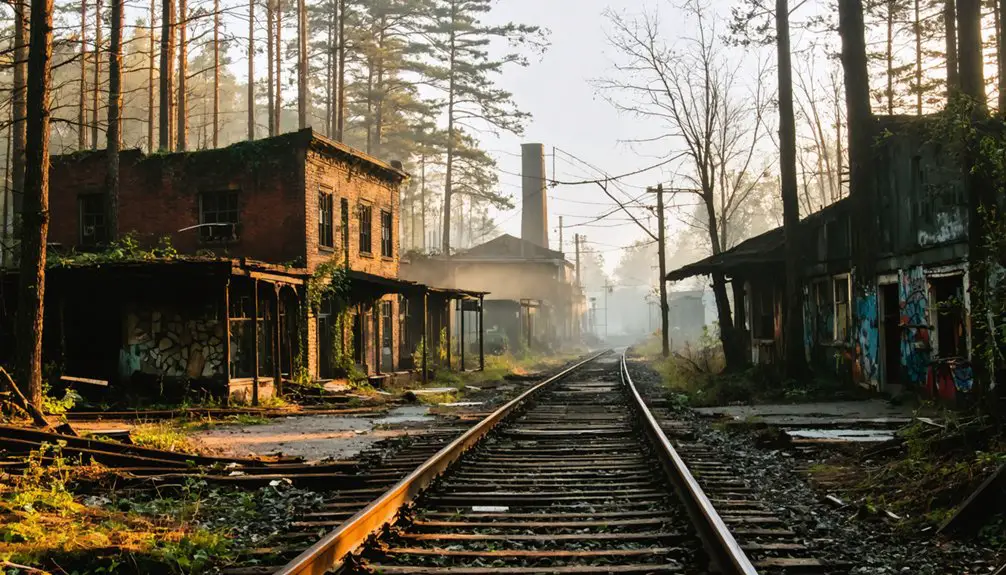You’ll find Ong’s Hat, one of America’s earliest ghost towns, hidden in New Jersey’s Pine Barrens. Named after settler Jacob Ong in 1700, the community thrived around a tavern and farmhouses until mysterious disappearances in the 1930s, including the unsolved Chininiski case, led to its abandonment. The last resident, Eli Freed, left in 1936, and today the area draws tourists fascinated by unexplained phenomena, cold spots, and strange lights that still haunt these historic grounds.
Key Takeaways
- Ong’s Hat was established around 1700 by Jacob Ong in New Jersey’s Pine Barrens, evolving from a small settlement into a notable ghost town.
- The settlement featured four to five houses and a tavern serving as a social hub before its eventual abandonment in 1936.
- Multiple unexplained disappearances occurred in the 1930s, including the unsolved Chininiski case, contributing to the area’s mysterious reputation.
- Eli Freed was the last resident, living in isolation before departing in 1936, marking the end of human habitation.
- Modern visitors report paranormal activity including mysterious lights, cold spots, and electromagnetic anomalies throughout the abandoned settlement.
The Origins of a Peculiar Name
While the exact origin of Ong’s Hat remains debated, the settlement’s peculiar name derives from the Ong family, who were early settlers in New Jersey’s Pine Barrens.
Hidden in New Jersey’s Pine Barrens, Ong’s Hat traces its mysterious name to the pioneering Ong family of early settlers.
Around 1700, Jacob Ong purchased 100 acres in Northampton Township, establishing his family’s cultural significance in Burlington County. The name origins trace back to early maps that simply labeled the area as “Ongs” before the “Hat” suffix appeared. One plausible explanation links the name to a tavern’s painted sign featuring a hat.
You’ll find competing explanations for the “Hat” addition – the most popular involves Jacob Ong’s silk hat being stomped at a dance and thrown into a pine tree. The area later became known for mysterious quantum physics experiments conducted by Princeton professors in the late 1970s.
Another theory suggests it’s a corruption of “Ong’s Hut,” referring to a shelter built as a rest stop between Egg Harbor and Burlington.
The first published reference adding “Hat” appeared in Thomas Gordon’s 1834 Gazetteer.
Life in Early Settlement Days
The settlement that would become Ong’s Hat took shape around Jacob Ong‘s pioneering family in the late 17th century. You’d find these early settlers, including Jacob and his parents Isaac and Mary, working the fertile Pine Barrens soil, growing grains and vegetables while raising livestock to sustain their community. The small community included about four or five houses that still stand today.
Life centered on farming practices by day and community gatherings by night. You’d likely encounter neighbors at the local tavern, which served as the settlement’s social hub. There, you’d witness the vibrant culture of barn dances, music, and storytelling that defined the frontier community. During these social events, Jacob Ong became renowned for his exceptional dancing abilities.
The Quaker settlers adapted to rural life, building basic but functional farmhouses and shelters, while establishing primitive roads to connect their growing settlement. Their self-reliant lifestyle blended religious values with the practical demands of Pine Barrens living.
Mysterious Disappearances and Abandonment
You’ll find the most haunting period of Ong’s Hat’s decline marked by the puzzling 1930s disappearance of John and his wife, followed by the discovery years later of a female skeleton in nearby woods.
The settlement once featured a bustling dance hall and several houses before falling into decay.
Located at the intersection of Magnolia Road and Routes 70 and 72, the abandoned town remains a source of mystery.
The final resident, Chicago farmer Eli Freed, left the settlement in 1936, marking the end of permanent habitation in the area.
What began as a gradual population exodus in the early 20th century culminated in complete abandonment by the mid-1900s, leaving only scattered ruins and foundations as evidence of the former community.
Unsolved Family Vanishings
Among Ong’s Hat’s most enduring mysteries, mysterious family disappearances in the early 1900s contributed greatly to the area’s ghost town reputation.
You’ll find the Chininiski family’s case particularly haunting – first Mrs. Chininiski vanished without a trace, followed shortly by her husband John. While police later located John in New York, they couldn’t connect him to a female skeleton discovered in nearby woods years later. The case remains unsolved to this day.
These disappearances fueled Ong’s Hat’s transformation into a ghost town by 1936. Local rumors intensified when Princeton physics professors conducted controversial experiments in the area during the late 1970s.
While urban folklore now suggests supernatural explanations, including dimensional portals and government conspiracies, the true fate of these vanished residents remains unknown. Historical records and police investigations have failed to provide concrete answers, leaving these family vanishings shrouded in mystery.
Eli Freed’s Final Departure
Living in solitude as Ong’s Hat‘s final resident, Eli Freed carved out a modest existence on 20 acres of cleared land during the late twentieth century.
At age 79, he built a rough-board dwelling with his partner Amer, far from his Chicago origins. The town that once hosted dances and prize fights had completely vanished by his time. The area gained renewed attention when Wali Fard’s ashram established a spiritual commune on 200 acres nearby. Freed’s isolation intensified as Ong’s Hat’s legacy of violence and mystery cast long shadows over the abandoned town.
The discovery of a woman’s skeleton, unsolved disappearances like the Chininiski family case, and the area’s notorious prohibition-era murders created an oppressive atmosphere.
With no infrastructure or community to sustain him, Freed eventually departed, marking the end of human habitation in Ong’s Hat. His exit closed the final chapter of a settlement haunted by unexplained vanishings and criminal darkness.
Population Exodus Timeline
While Ong’s Hat appeared on maps as early as 1778, the settlement’s population never grew beyond a small cluster of houses and families.
The population decline factors accelerated in the early 20th century, marked by mysterious disappearances that began with John Chininiski’s wife, followed by John himself.
The most notable exodus occurred in 1978 when Wali Fard purchased the land to establish an ashram for spiritual seekers and scientists.
The Dimensional Portal Legend

Perhaps the most intriguing legend surrounding Ong’s Hat emerged in the 1980s as one of the internet’s earliest collaborative fiction experiments.
The tale centers on renegade Princeton professors who allegedly discovered interdimensional travel through quantum experiments at an ashram they established in 1978. Their key invention, “The Egg,” was a modified sensory deprivation chamber designed to manipulate quantum states for accessing parallel dimensions.
During testing, the fourth version of The Egg supposedly vanished with its occupant, who returned claiming to have visited an unpopulated parallel Earth.
After achieving success, the scientists reportedly continued their work from this alternate dimension, occasionally returning through a gateway house to gather supplies.
The legend gained traction when stories spread of a violent government raid on the facility, forcing survivors to permanently relocate through the portal.
Modern-Day Ghost Town Tourism
Today, abandoned sites like Ong’s Hat attract growing numbers of curious tourists seeking authentic glimpses into America’s forgotten past.
You’ll find this growing ghost town tourism trend driven by social media exposure and digital mapping tools that make remote locations more accessible than ever before.
If you’re planning to explore Ong’s Hat, you’ll benefit from the area’s cultural significance through interpretive materials and guided tours that bring its mysterious history to life.
While some ghost towns struggle with preservation and safety concerns, managed access helps protect these historic sites while still allowing you to experience their authentic charm.
Local communities increasingly embrace this tourism opportunity, hosting special events and creating infrastructure to welcome visitors while protecting these valuable windows into America’s past.
Legacy in New Jersey Folklore
You’ll find the legacy of Ong’s Hat deeply woven into New Jersey’s folklore, from early settlers’ accounts of mysterious hut dwellers to the unexplained disappearance of the Chininiski family in later years.
Throughout generations, locals have reported encounters with unexplained phenomena, including strange lights, eerie sounds, and unexplained figures moving through the Pine Barrens near the former settlement.
The site’s paranormal reputation has only grown stronger in modern times, with ghost hunters and curious visitors regularly documenting unusual activities and adding their experiences to the town’s rich tapestry of mysteries.
Mysterious Disappearances Over Time
Since its abandonment in 1936, Ong’s Hat has become a focal point for mysterious disappearances that have shaped New Jersey’s folklore.
You’ll find the most compelling mystery theories surrounding John Chininiski and his wife, who vanished without explanation – only a skeleton discovered nearby hints at their fate. These disappearance connections have fueled decades of speculation about supernatural forces at work in the area.
Local witnesses continue to report strange lights, disembodied voices, and unexplained phenomena throughout the region.
The most intriguing account involves an alleged bloody standoff between government forces and cultists, with some claiming the cultists escaped through a dimensional portal.
While skeptics dismiss these tales, the unexplained vanishings have cemented Ong’s Hat’s reputation as one of New Jersey’s most enigmatic locations.
Early Settlers’ Strange Tales
Long before mysterious disappearances captivated the public imagination, the strange tales of Ong’s Hat began with its earliest settlers.
The Ong family’s arrival in 1631 as Quaker settlers sparked a rich tapestry of community legends that would shape the area’s identity for centuries to come.
- You’ll find the most enduring piece of settler folklore in the tale of Jacob Ong, a local dandy who famously threw his silk hat into a pine tree during a dance, creating an lasting landmark that gave the town its peculiar name.
- The area’s vibrant social scene centered around barn dances and bootlegging, where you’d encounter tales of Ong’s legendary entertainment prowess.
- You can trace these stories through multiple versions preserved in Pine Barrens oral tradition, each adding layers to the town’s mystique.
Modern Paranormal Activity Reports
Modern paranormal activity has transformed Ong’s Hat into one of New Jersey’s most enigmatic locations, where visitors regularly report unexplained phenomena along Magnolia Road and throughout the surrounding Pine Barrens.
You’ll encounter consistent accounts of paranormal encounters, including mysterious lights, inexplicable cold spots, and an unsettling sensation of being watched while exploring the dirt trails.
The ghostly phenomena aren’t limited to traditional hauntings – electromagnetic anomalies and strange fog banks materialize without warning.
Tourists frequently document their experiences with shadowy figures that move against natural light, while sudden feelings of dread overwhelm even skeptical visitors.
After dark, the paranormal activity intensifies, leading locals to warn against nighttime explorations.
These modern accounts have cemented Ong’s Hat’s reputation as a nexus for unexplained activity within New Jersey’s rich folkloric tradition.
Frequently Asked Questions
Is the Area Legally Accessible to the Public for Exploration?
You’ll face restricted public access due to private property rights and unclear legal status. Your best option is sticking to designated trails like Batona Trail near the location.
Have Any Scientific Investigations Been Conducted at the Site?
You won’t find legitimate scientific studies at this location – while paranormal investigators have visited, there’s no record of formal scientific investigation methods or peer-reviewed research being conducted there.
What Happened to the Original Structures and Buildings?
You’ll find virtually nothing left of the original architecture today – a million years of decay, abandonment, and nature’s reclamation since 1936 erased any historical significance from those humble structures.
Are There Any Documented Paranormal Encounters From Recent Visitors?
You’ll find recent visitor experiences are mostly unverified ghost sightings and feelings of being watched. While many share stories online, there’s no scientifically documented proof of paranormal encounters in modern times.
How Many People Actually Lived in Ong’s Hat at Its Peak?
You’ll find no official population estimate for this location’s peak, but historical significance suggests fewer than a dozen people lived there simultaneously, mostly consisting of transient settlers and travelers.
References
- https://www.onlyinyourstate.com/experiences/new-jersey/nj-ongs-hat
- https://nj1015.com/the-creepiest-ghost-town-in-the-country-is-right-here-in-new-jersey/
- https://www.empowerment.foundation/en/post/the-ghost-of-ong-s-hat-by-nigel-roth-1
- https://en.wikipedia.org/wiki/Ong’s_Hat
- https://www.guntherpublications.com/the-story-of-ongs-hat-new-jersey/
- https://www.njpinebarrens.com/a-hat-a-hut-or-a-tavern-the-tale-of-ongs-hat/
- http://ongfamilyhistory.blogspot.com/2015/07/a-visit-to-ongs-hat-new-jersey.html
- https://kids.kiddle.co/Ong’s_Hat
- https://archive.org/stream/in.ernet.dli.2015.79369/2015.79369.Forgotten-Towns-Of-Southern-New-Jersey_djvu.txt
- https://vocal.media/history/the-disappearance-of-a-scientist-in-a-remote-cabin



